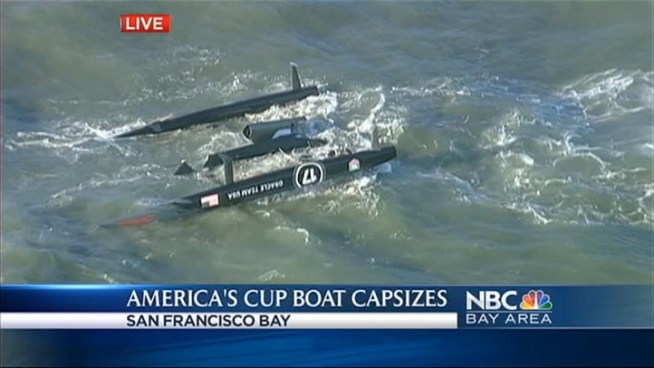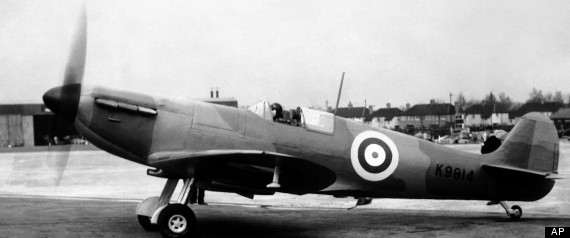
Jeff Haynes / AFP - Getty Images, file
The
HMS Bounty, a replica used in the Marlon Brando movie "Mutiny on the
Bounty," sails past the Chicago skyline in this image from July 2003.
Updated at 10:15 a.m. ET: A search was under way Monday for two crew members of the stricken ship HMS Bounty, which was sinking off the coast of North Carolina, the U.S. Coast Guard said.
Earlier Monday, two Coast Guard helicopters rescued 14 people from life rafts after they were forced to abandon ship. They were being flown to Air Station Elizabeth City in North Carolina where they would be met by awaiting emergency medical services personnel, the Coast Guard said in a statement on its website.
An aircraft was on the scene, searching for the two missing crew members, with a Jayhawk helicopter en route to assist.
The ship issued a distress signal late Sunday after taking on water, the U.S. Coast Guard said.
The owner of the 180-foot, three mast ship -- which was built for the 1962 Marlon Brando movie, "Mutiny on the Bounty" -- lost communication with the crew and alerted the Coast Guard to the situation.
The Coast Guard then received a distress signal from the ship showing its position. It sent out an aircraft to speak with the crew, which reported that the vessel was taking on water and had no propulsion. It was located about 90 miles southeast of Hatteras, N.C.
“The 16 people donned cold water survival suits and life jackets before launching in two 25-man lifeboats with canopies,” the Coast Guard said in the statement. It had earlier reported that there were 17 people aboard the ship.
The director of the HMS Bounty Organization, Tracie Simonin, said that the tall ship left Connecticut last week for St. Petersburg, Fla. The crew had been in constant contact with the National Hurricane Center and tried to go around the storm, she said.
The ship, which is still floating upright and intact, is surrounded by 18-foot seas and 40 mph winds as Hurricane Sandy moves through the area.
Glimpse into maritime historyThe Bounty makes frequent trips around the country, offering a glimpse into maritime history, according to the ship's website, which now appears to be down. It was originally a British transport vessel, and the replica has appeared in several films, including the 2006 movie "Pirates of the Caribbean: Dead Man's Chest," with Johnny Depp. Its last stop before its winter hiatus in Galveston, Texas, was to be in St. Petersburg, Fla., on Nov. 10.
It is unclear why the boat set out to sea with Sandy bearing down. Sandy could be the largest storm ever to hit the United States, according to NOAA's website.
The storm strengthened overnight off the mid-Atlantic coast and is expected to bring a "life-threatening storm surge" to affected areas.
Maximum sustained winds of about 85 miles per hour were recorded 385 miles southeast of New York City, which forecasters warned could be hit by a wall of water up to 11 feet high.
The storm was forecast to make landfall Monday night, likely in central or southern New Jersey.
In anticipation of widespread damage and vast power outages, states of emergency were declared in North Carolina, Virginia, Maryland, Pennsylvania, New Jersey, New York, Connecticut, Rhode Island, Massachusetts and the District of Columbia.
Updated at 10:15 a.m. ET: A search was under way Monday for two crew members of the stricken ship HMS Bounty, which was sinking off the coast of North Carolina, the U.S. Coast Guard said.
Earlier Monday, two Coast Guard helicopters rescued 14 people from life rafts after they were forced to abandon ship. They were being flown to Air Station Elizabeth City in North Carolina where they would be met by awaiting emergency medical services personnel, the Coast Guard said in a statement on its website.
An aircraft was on the scene, searching for the two missing crew members, with a Jayhawk helicopter en route to assist.
The ship issued a distress signal late Sunday after taking on water, the U.S. Coast Guard said.
The owner of the 180-foot, three mast ship -- which was built for the 1962 Marlon Brando movie, "Mutiny on the Bounty" -- lost communication with the crew and alerted the Coast Guard to the situation.
The Coast Guard then received a distress signal from the ship showing its position. It sent out an aircraft to speak with the crew, which reported that the vessel was taking on water and had no propulsion. It was located about 90 miles southeast of Hatteras, N.C.
“The 16 people donned cold water survival suits and life jackets before launching in two 25-man lifeboats with canopies,” the Coast Guard said in the statement. It had earlier reported that there were 17 people aboard the ship.
The director of the HMS Bounty Organization, Tracie Simonin, said that the tall ship left Connecticut last week for St. Petersburg, Fla. The crew had been in constant contact with the National Hurricane Center and tried to go around the storm, she said.
The ship, which is still floating upright and intact, is surrounded by 18-foot seas and 40 mph winds as Hurricane Sandy moves through the area.
Glimpse into maritime historyThe Bounty makes frequent trips around the country, offering a glimpse into maritime history, according to the ship's website, which now appears to be down. It was originally a British transport vessel, and the replica has appeared in several films, including the 2006 movie "Pirates of the Caribbean: Dead Man's Chest," with Johnny Depp. Its last stop before its winter hiatus in Galveston, Texas, was to be in St. Petersburg, Fla., on Nov. 10.
It is unclear why the boat set out to sea with Sandy bearing down. Sandy could be the largest storm ever to hit the United States, according to NOAA's website.
The storm strengthened overnight off the mid-Atlantic coast and is expected to bring a "life-threatening storm surge" to affected areas.
Maximum sustained winds of about 85 miles per hour were recorded 385 miles southeast of New York City, which forecasters warned could be hit by a wall of water up to 11 feet high.
The storm was forecast to make landfall Monday night, likely in central or southern New Jersey.
In anticipation of widespread damage and vast power outages, states of emergency were declared in North Carolina, Virginia, Maryland, Pennsylvania, New Jersey, New York, Connecticut, Rhode Island, Massachusetts and the District of Columbia.



 Digging for what remains of Kublai Khan's fleet. Photo: Photo courtesy of the Bach Dang Battlefield Research Group
Digging for what remains of Kublai Khan's fleet. Photo: Photo courtesy of the Bach Dang Battlefield Research Group
